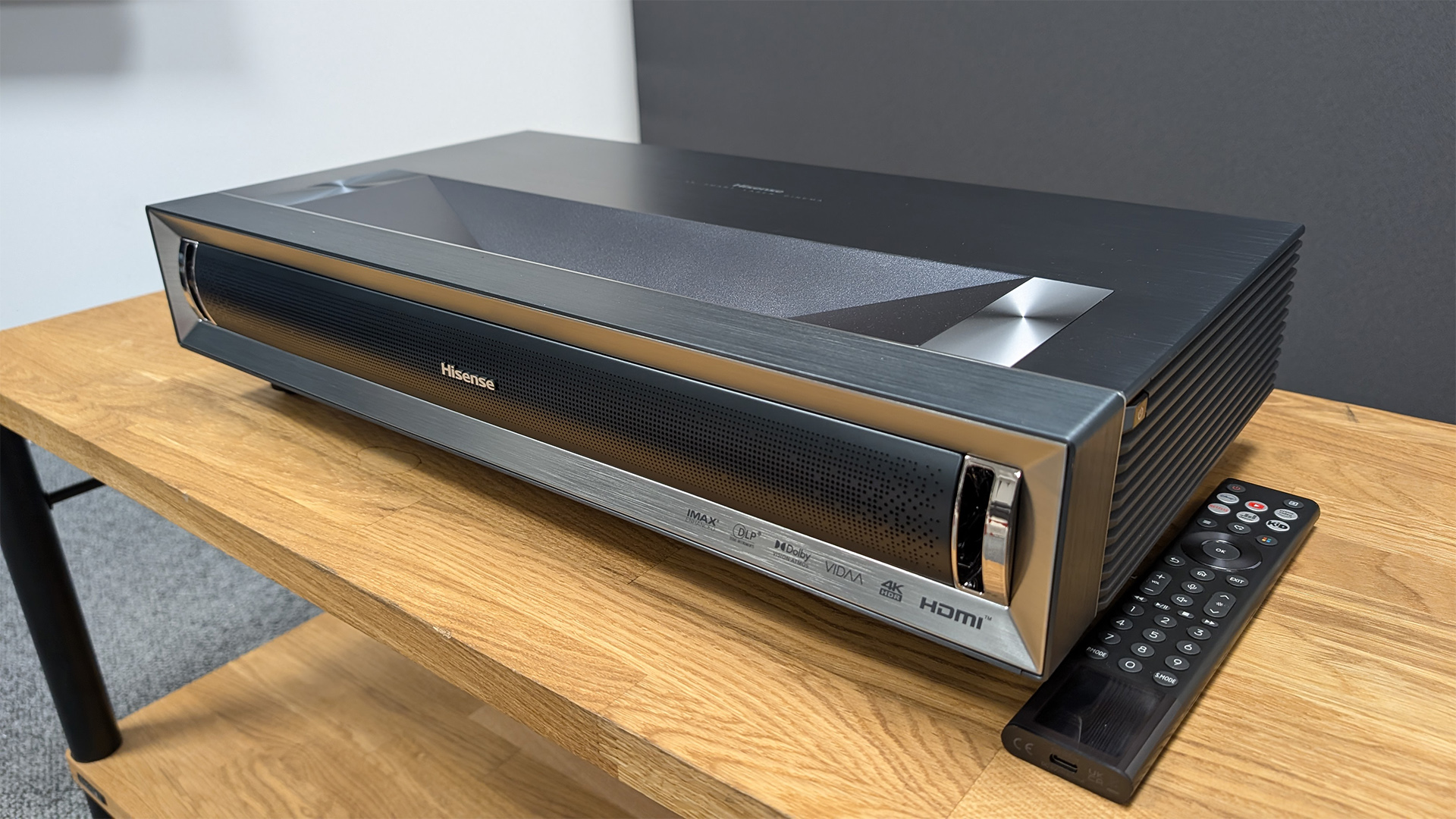
The Hisense PX3-Pro is the latest ultra short throw projector (UST) from tech giant Hisense. It is a big deal for a couple of reasons. First, because it’s a follow-on to the five-star Award-winning Hisense PL1. Second, because it is one of the only projectors we’ve tested this year to carry ‘designed for Xbox Series’ certification, which aims to make it great for gamers as well as movie fans.
If the overt focus on gaming has you concerned that it won’t be good for watching films, don’t be. During testing, we found the PX3-Pro is a big upgrade on Hisense’s previous UST offerings and fantastic for watching movies as well as blasting demons in Doom.
Price
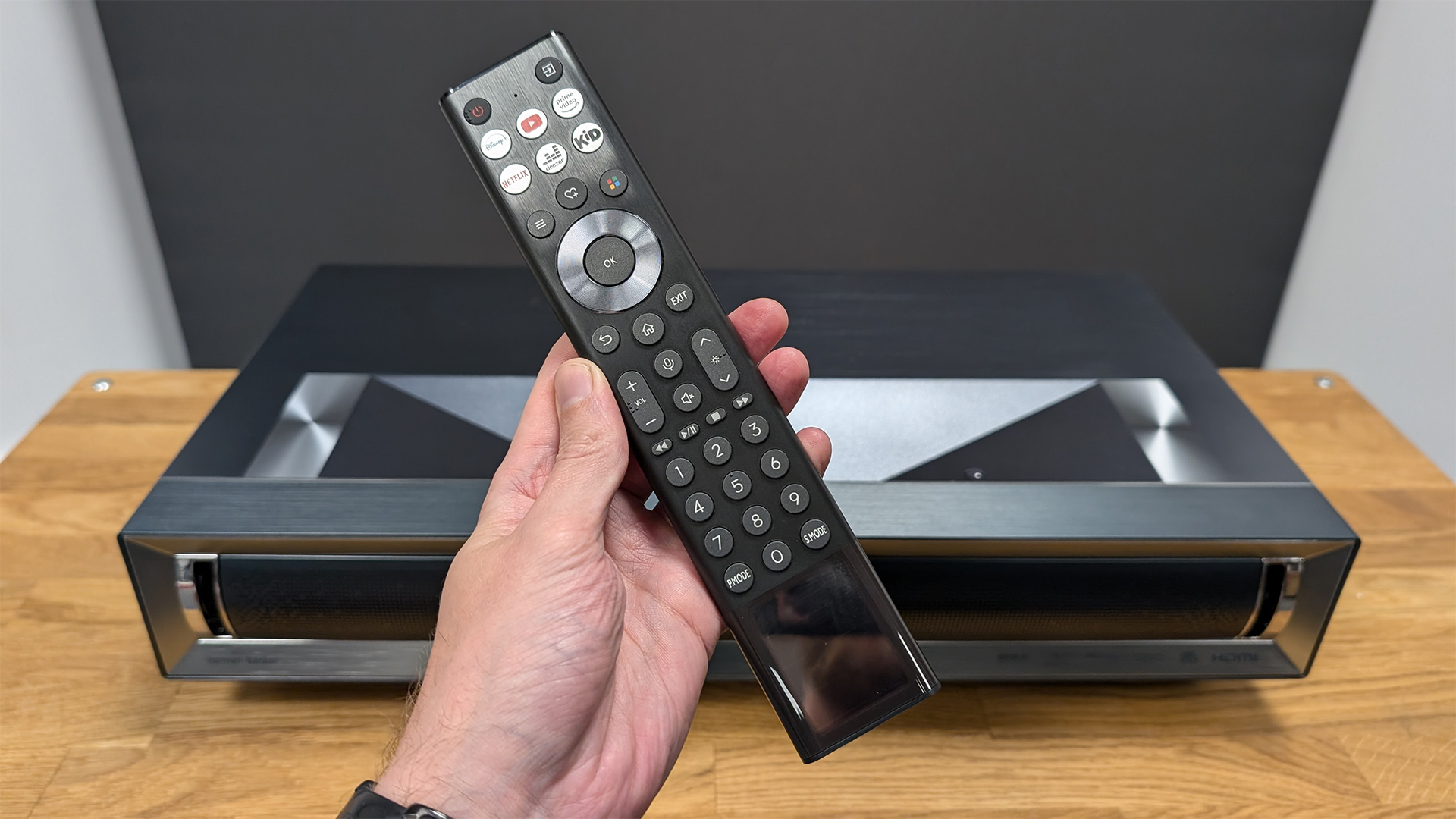
The Hisense PX3-Pro is a new product that currently costs £2499 / $3499 / AU$4499. That places it in the middle of the UST projector market.
It’s more expensive than its What Hi-Fi? Award-winning PL1 sibling, which carried a £1999 / $2500 / AU$2995 price at launch, but more affordable than the soon-to-be-replaced Samsung The Premiere LSP9T. The latter retails for £3999 / $3500 / AU$8999 and is the only premium UST projector to which we've recently given five stars.
This makes the PX3-Pro an interesting option, as we’re yet to find a UST projector we 100 per cent recommend this year that sits in the same price bracket. The rival Epson EH-LS650 proved to be a good but not great option, scoring four stars when we tested it.
Build
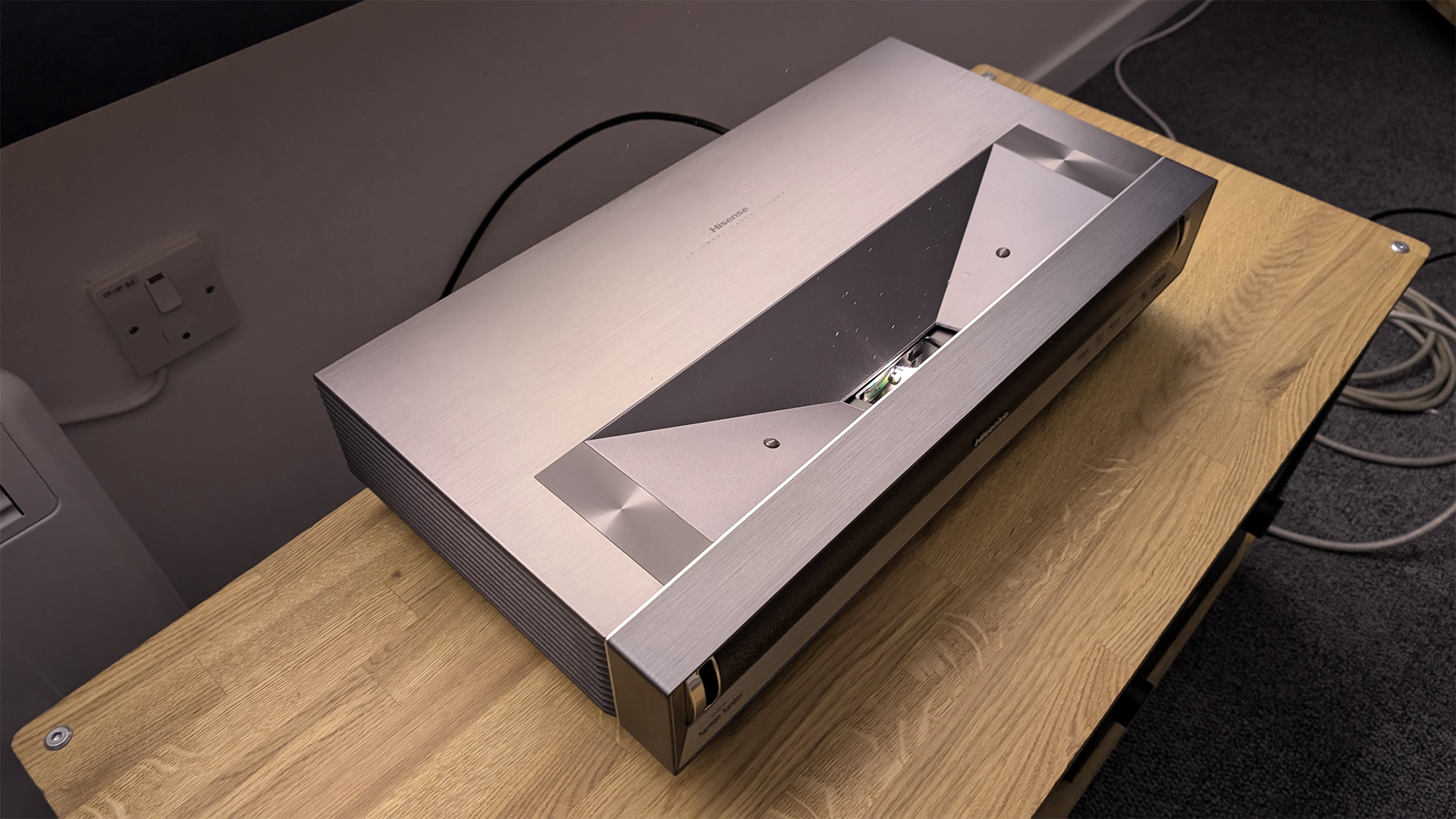
Gaming products usually come with garish designs with things like tribal patterns and RGB lighting. Thankfully, this isn’t the case on the PX3-Pro, which has a suitably minimalist, mature design.
The distinctly angular unit comes with a grey metallic finish that feels robust and feels hefty enough that it won’t easily move once placed on a flat surface – even if you have pets that like to “move” items when you’re away.
The only obvious design features are a metal grille on its front that covers its inbuilt 50-watt front-firing Harman Kardon speakers, which are Dolby Atmos and IMAX Enhanced DTS ready, and side vents. The latter help to control airflow from the projector’s fan cooling system.
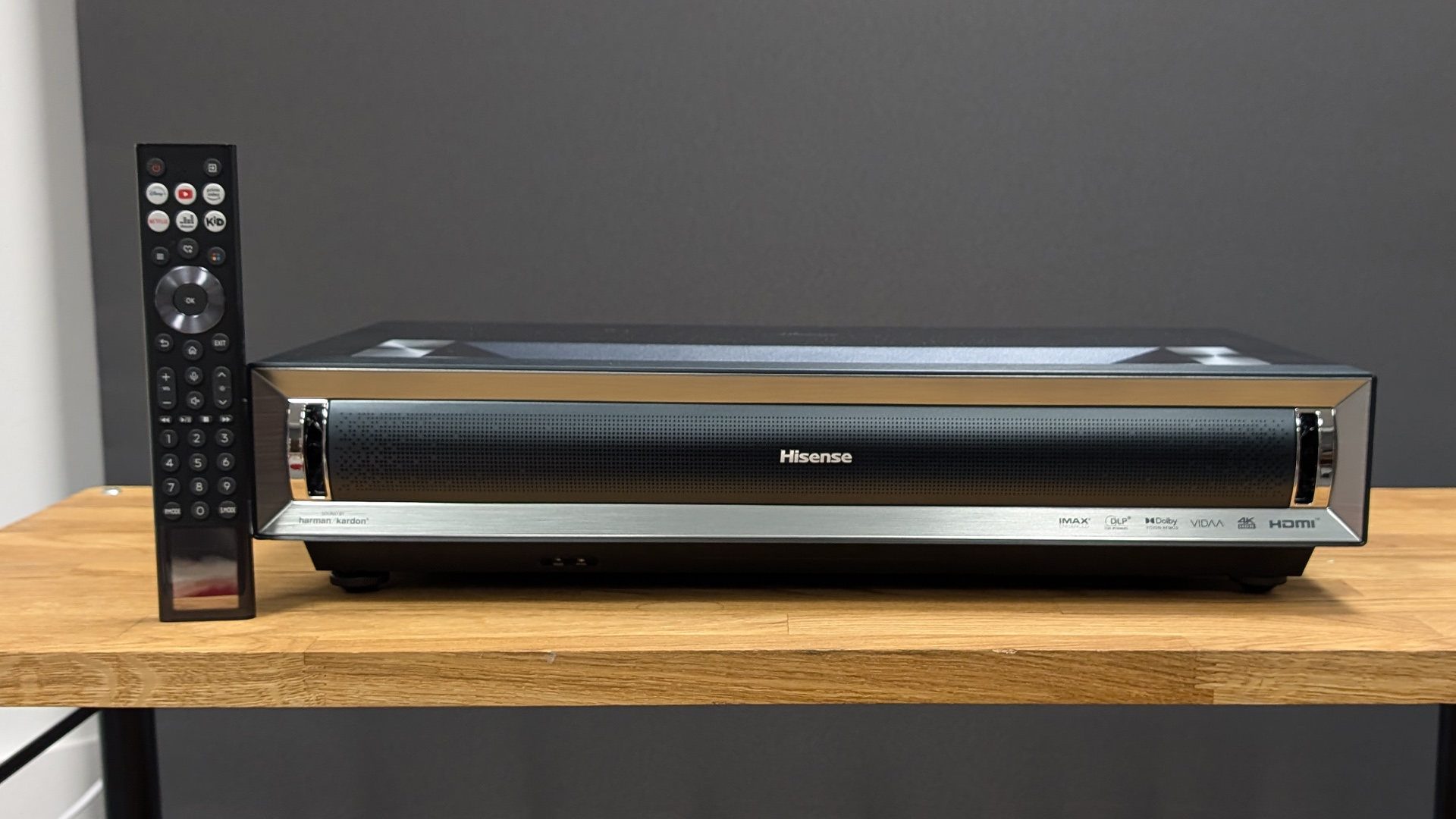
Resolution 4K (3840 x 2160)
HDR Dolby Vision, HDR10+, HDR10, HLG
Light source Trichroma RGB laser light
Operating system Google TV
Picture size 80-150 inches
Contrast 3,000:1
Brightness 3000 ANSI Lumens (2600 Peak Lumens)
HDMI 2x HDMI 2.1, 1x HDMI 2.0 with eARC
The 55 x 30 x 12.2cm dimensions mean it is a little longer and shallower than some cheaper USTs, but the low height means it will neatly fit on most TV stands, cabinets and bookshelves. This is important for a UST, which is designed to not draw attention until it's turned on.
The reason it is longer but thinner than many of its siblings is that the PX3 has a 0:22:1 throw ratio, which lets it create a larger image, even when sitting very close to a wall. Its predecessor had a 0.25:1 throw ratio by comparison. The adjustable feet also make it relatively easy to adjust its level and picture positioning, which is good as there’s no physical lens control – a common problem we’d like fixed on USTs.
Set-up is fairly simple by UST standards, but not completely seamless. The projector relies on keystone and digital picture correction. In theory, you can set it up automatically by taking a photo of a test pattern displayed on the screen/wall on your phone and uploading it to a Hisense website, which then adjusts the picture settings for you.
However, after three attempts we find the image is still slightly skewiff using this process, and we end up making manual adjustments to get the best results. This involves a good five minutes of fandangling, even with two sets of eyes and hands.
The PX3-Pro is also part of Hisense’s Laser Cinema, rather than Laser TV, line, which means it doesn’t come with a screen bundled. You’ll need to invest in one if you want the best results possible.
The remote is decent, featuring the same solar panel (which uses light to top up the battery) as the Hisense U8N Mini LED TV we reviewed earlier this year. It also has shortcut keys to all the common services. The only minor downside is that it’s not backlit, which for a projector that needs to be used in the dark for decent results, is a bit of an annoyance.
Features
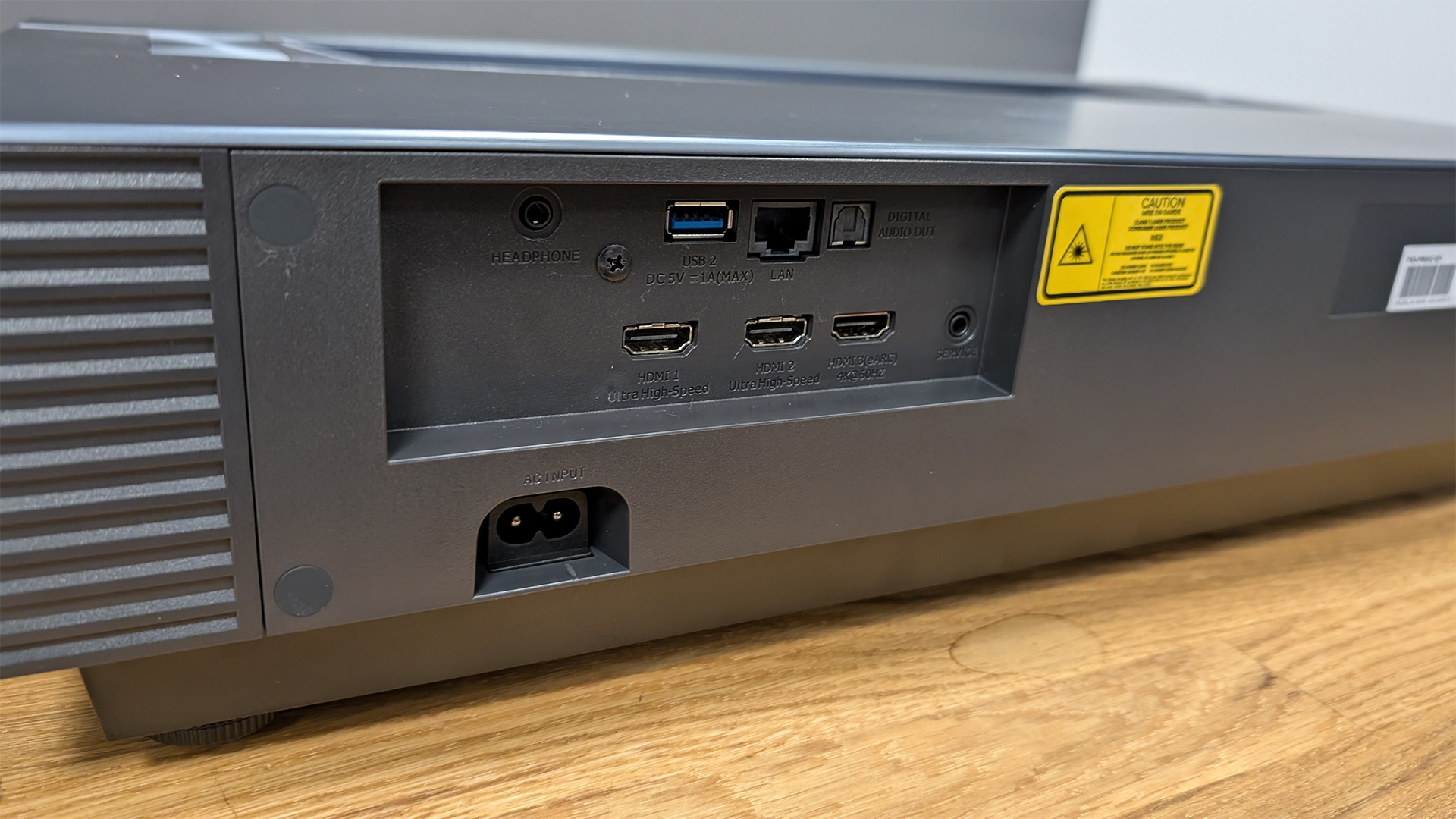
Hisense may be marketing the PX3-Pro mainly to gamers, but it has done a lot of work to improve its basic picture and audio quality compared with the PL1 and its direct predecessor, the PX2-Pro.
At a base level, these include the ability to display a native contrast of 3000:1, an improved 3000 ANSI lumens max brightness and the ability to display a quoted 110 per cent of the BT.2020 colour space favoured by movie creators. The projector is quoted as offering 25,000-plus hours of light source life, which is in line with the PL1 and equates to roughly three years of continuous watching.
What does all of that mean? The layman’s version is that the projector has been designed to show a wider, more accurate range of colours, offer much higher peak brightness levels and significantly deeper, more detailed blacks than its siblings. For reference, the PL1 has a 2000:1 contrast ratio and 2100 ANSI lumens peak brightness.
Other firsts for Hisense include IMAX Enhanced support. This will be a welcome addition for subscribers to Disney Plus, which now carries IMAX Enhanced content. HDR10+ will also be of benefit to people who mainly watch movies on Amazon Prime Video. This is a take on basic HDR10 that adds frame-by-frame brightness and colour correction for HDR images. HDR support is rounded out with HDR10, Dolby Vision and HLG.
Gaming support is also excellent for a projector, which is to be expected given Hisense’s focus on selling the PX3-Pro as ‘made for Xbox Series consoles'. Around the back, you’ll find two HDMI 2.1 inputs and an HDMI 2.0 output with eARC, plus a USB A and 3.5mm audio output. There’s also an ethernet for cabled internet connections, though its onboard chip supports Wi-Fi 6E if you can’t place it near your router or mesh satellite.
Unlike many UST projectors, the big selling point here is that the HDMI 2.1 inputs can run games in 4K/120Hz. So if you connect an Xbox Series X/S or PS5, the consoles can run at full speed. Interestingly, there’s also the ability to play games in 1080p/240Hz, which isn’t a feature we’ve seen on a UST before. This will only appeal to PC gamers with very powerful graphics cards that can run games that fast, however.
An auto low latency mode (ALLM) is another useful feature, as it automatically puts the projector into its fast-response game mode when an appropriate signal is detected, avoiding the issue of sluggish-feeling games.
The inclusion of eARC also makes it quick and easy to connect it to an external Dolby Atmos sound system – which requires the input to run.
Our UK/European review unit runs Hisense’s Vidaa OS. But if you buy the PX3-Pro in the US, it will come with Google TV. Both come with support for all the common apps you’d expect, including Netflix, Disney Plus, Amazon Prime Video and Apple TV+. The Vidaa version we tested also has a decent selection of UK catch up apps and local services, including BBC iPlayer and Now.
Picture
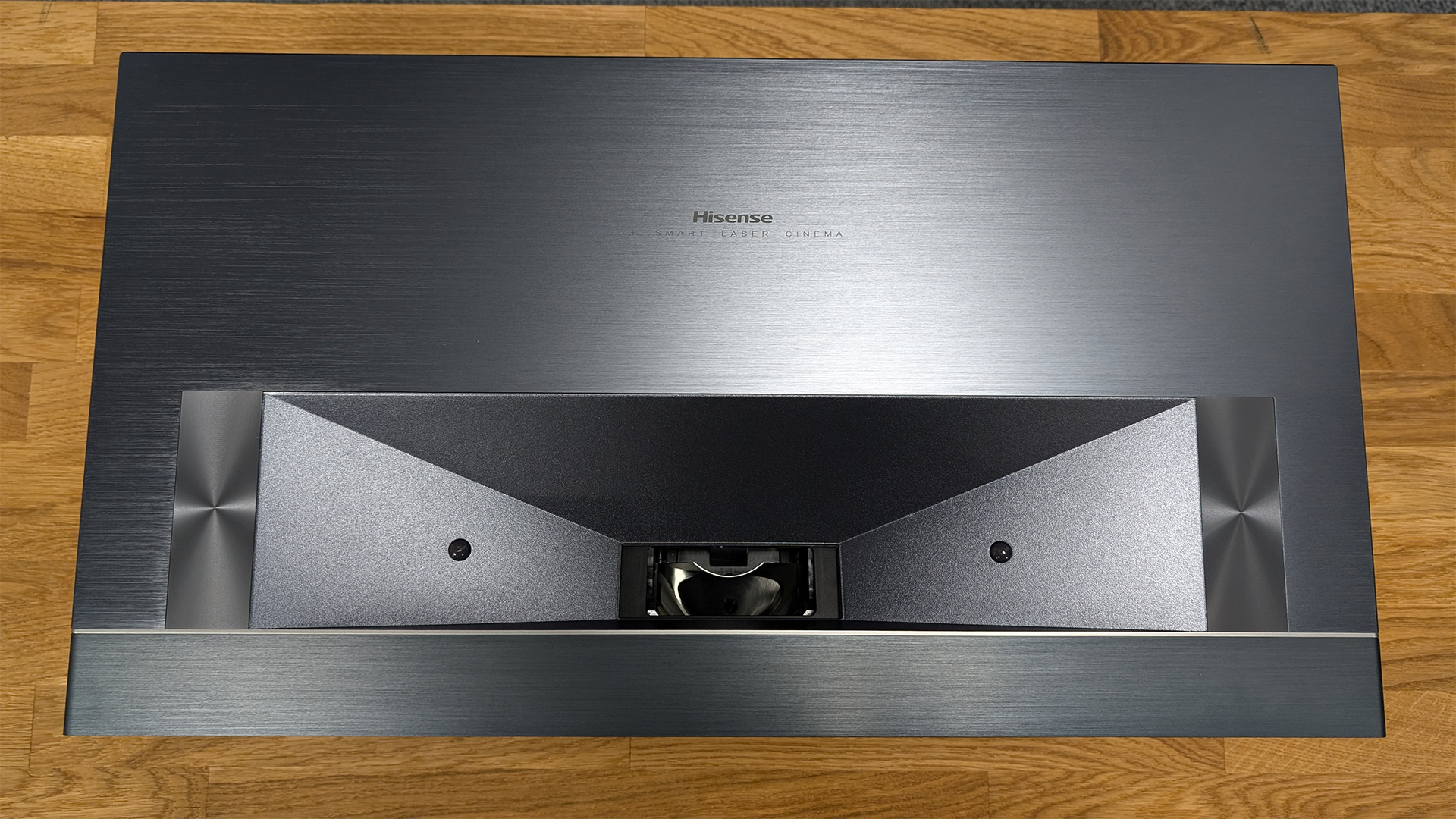
Out of the box, the PX3-Pro offers competent but not best in class picture quality. Running our tried and tested Dune Part 2 4K Blu-Ray, the standard mode’s motion handling feels a little too heavy handed, and the contrast is slightly too high, resulting in a loss of detail in both dark and light areas.
Switching to Filmmaker Mode, the picture goes too far the other way, with motion looking natural, but the picture feeling too subdued and slightly flat – blacks are slightly grey and peak brightness areas of the sweeping desert don’t gleam the way they should.
We get the best results returning to the PX3’s HDR Standard setting, with the Adaptive Contrast level set to Medium, Dynamic Tone Mapping on, all motion smoothing settings completely off and the Colour Profile set to Warm 2. The last of those is particularly valuable, as it makes skin tones look more natural, giving the cheeks of the desert-dwelling Fremen more warmth and a more authentic sandblasted feel than the default Warm 1 setting provides.
Moving to Blade Runner 2049, the PX3-Pro continues to impress. As Ryan Gosling’s character enters the dust-filled protein farm, there’s oodles of detail in the wind-swept barren landscape. The projector offers realistic but vibrant colours, with the reds of Sapper Morton’s suit popping from the otherwise grey shot, without looking overcooked.
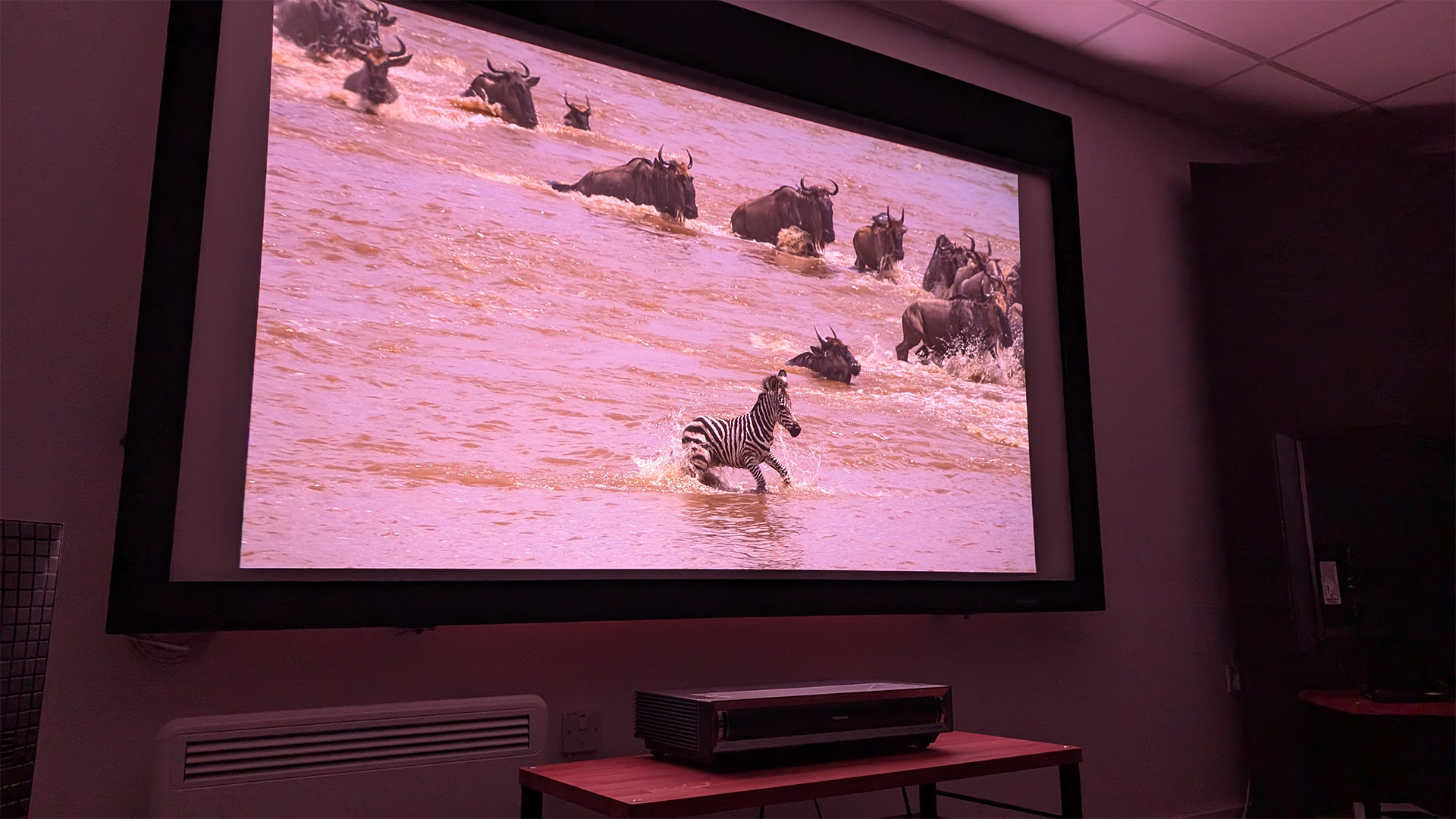
Light control for a UST is also a cut above many rivals, with the picture looking wonderfully three-dimensional. Highlights around the steaming kettle resulting from stray light emanating from a dirty window offer true depth, making for an authentic, immersive viewing experience. Morton’s movements as he throws K around the room feel violent, and have incredible heft, with no hint of oversmoothing. The only minor issue is that with all motion handling switched off, some particularly fast movements feel slightly jagged. However, the moment we adjust the motion handling to its lowest setting, an artificiality is added to the movements. Ideally, we’d like a happy medium between the two.
To our surprise, the PX3-Pro also performs better than expected in an area in which projectors (particularly recent USTs) tend to struggle – dark detail. Watching an incredibly dark scene from The Batman, there is a little black crush, as the PX3’s contrast has been cranked to make blacks appear deeper. And yes, they still appear as dark grey, rather than the perfect black you’ll find on even an entry-level OLED. But there’s significantly more detail than you get from many competing USTs, including the Hisense PL1. Details in Batman’s armour lost on the PL1 and Xgimi Aura 2 remain visible as he menacingly walks out of the shadows.
This remains the case when we switch to Oppenheimer. Every stitch in the characters' wool suits and ties remain visible, even in the darkest sections of the black and white scenes. This is something no other UST we’ve reviewed this year has managed.
At the other end of the spectrum, the Hisense’s unusually high brightness quickly becomes apparent when playing our reference Pan test disc, which is mastered to an atypically high 4000 nits. As the flying pirate ship sails into the sunset, the PX3-Pro delivers decent peaks in the brightest parts of the picture, with the sunset offering a wonderful hue full of warmth. Our only minor quibble is that we wish the sunset held slightly more detail, with a lot of the sun displaying as pure white.
Testing the Dolby Vision performance with Rogue One: A Star Wars Story reveals a wonderful bloom and immersive peaks, with stars and the halos around planets truly sparkling as the spaceship shoots across the screen.
The only serious weakness we experience occurs as we move on to our upscaling test, which initially involves playing a 1080p Blu-ray of True Grit. This is a famously difficult movie due to its intentional grainy, spaghetti-western quality. Here, the PX3-Pro immediately struggles. As the credits roll, a disappointing issue occurs where the picture’s black level rapidly shifts to grey, before returning to its normal level as the next part of the white intro text appears. It seems that the projector’s contrast system isn’t sure whether it should be boosting the white highlights or responding to the black background.
During the next scene, the PX3-Pro delivers more detail than the PL1, revealing picture elements that the cheaper projector misses, such as the trees and the shadow of a rocking chair. But there’s still a lot of black crush, with entire sections of the picture appearing as dark grey and the stitched texture of the character's clothes appearing flatter than we’d like. The grain also takes on a slightly artificial quality, feeling either over pronounced or noisy as the scene continues.
Moving to Netflix and Schitts’ Creek in SDR, the issue with the black level moving from dark to light sections doesn’t repeat and the image is watchable, with characters’ skin tones looking realistic. But dark segments of the picture still look flattened. The pattern of the father’s suit comes across as a flat blue.
Sound

Out of the box, we find the Hisense’s inbuilt, Atmos-ready speaker system is fine for casual viewing, but still not on a par with the sound of a good soundbar, let alone a speaker package.
Playing our standard Blade Runner 2049 test scene, which includes a booming bass section that drives anything but the most accomplished speakers to distortion, the Hisense's speakers struggle. Distortion creeps in and the audio sounds forced. Moving to a dialogue-heavy debrief section, the audio sounds flat and not suitably immersive.
Thankfully, switching to the theatre sound profile things improve markedly. The sound as K converses with a hologram in his apartment is immediately wider and there’s a better separation between their dialogue and background noise.
Switching to a car chase in The Batman, the speaker system does manage to give at least some sense of direction, with the rumbling engine of the Batmobile jumping from left to right, remaining roughly in line with the on screen movements. However, given its central location on the chassis, the speakers don’t manage to deliver any sense of height and fail to project forward enough for our liking.
The audio also constantly feels strained. The Batmobile’s engine rumble lacks finesse and is prone to distortion. Dialogue during heated scenes as Batman growls threats at gangsters has an acidic, hissed quality that can at times break immersion. The thumps as his punches connect have a damp quality missing the impact they need to do the fight scene justice. This issue makes the sound particularly problematic, as the sibilance and thin nature of the audio constantly distracts rather than immerses.
To be fair to Hisense, poor audio is a common problem we experience with USTs and projectors in general, so this shouldn’t put you off the PX3-Pro. It just means we would recommend investing in a separate sound system if you want a truly immersive home cinema experience.
Verdict
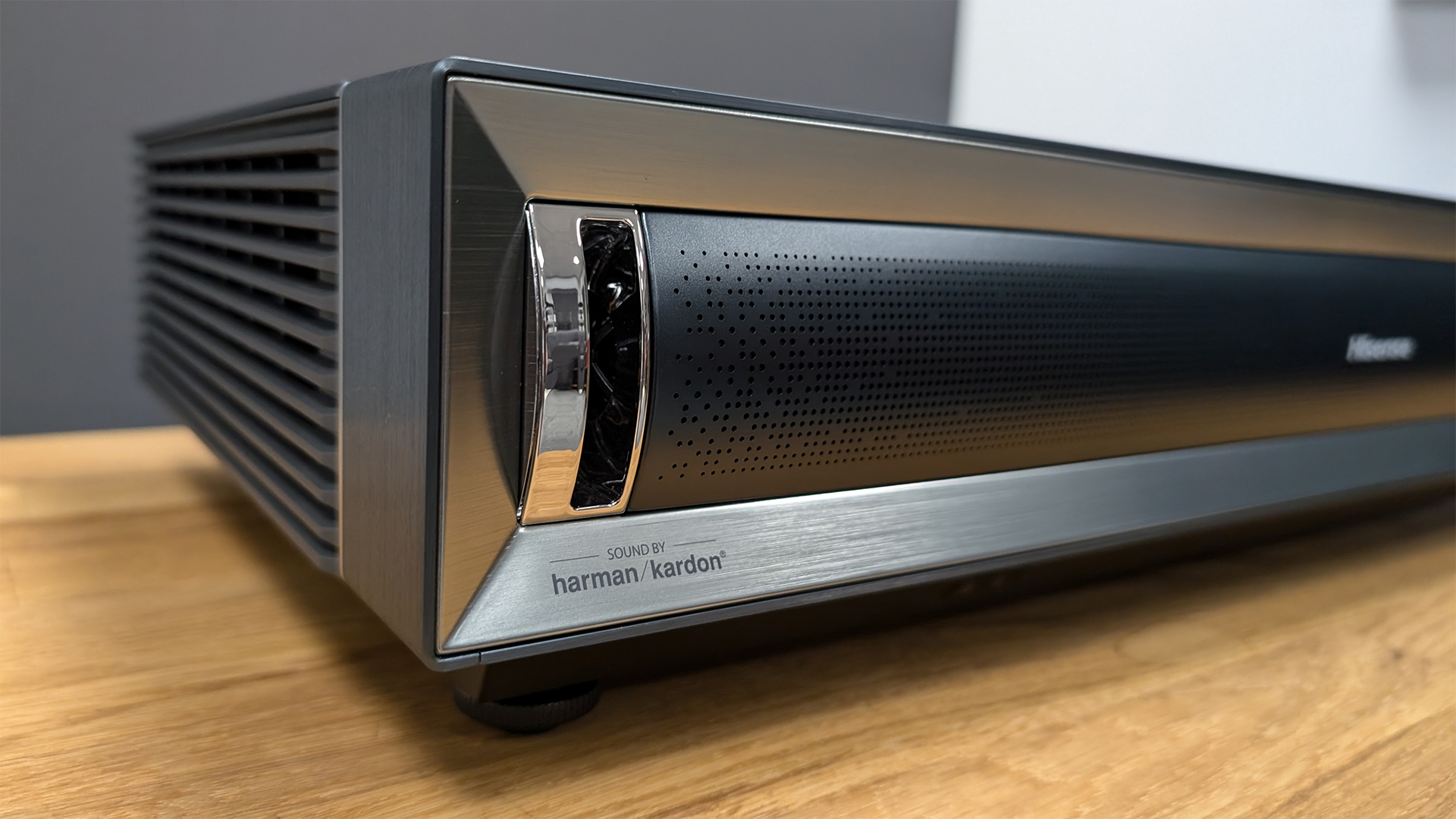
The Hisense PX3-Pro is a great UST projector for movie fans and gamers. Though the projector’s audio is undeniably mediocre, even by UST standards, its picture quality more than makes up for this. The PX3-Pro’s handling of dark scenes is particularly excellent by UST standards, and in general its picture is a marked improvement on any other projector in its class we’ve tested.
If you’re short on space, own an Xbox and love watching movies then the Hisense PX3-Pro is well worth considering. The only downside is that it doesn’t do a great job with SDR discs, which will be an issue for people with large Blu-ray collections.
Review published: October 2024. Review updated: November 2024.
SCORES
- Picture 5
- Sound 3
- Features 5
MORE:
Read our review of the Hisense PL1
Also consider Samsung's The Premiere LSP9T
Read our Epson EH-LS650 review







